Dental Office Computer Software vs. Traditional Systems: What Works Best
Running a dental clinic efficiently requires the right tools. Many clinics still use manual systems, but these are prone to errors, time delays, and inefficiencies. Dental office software, on the other hand, automates key tasks like scheduling, billing, and patient record management, offering a streamlined, digital solution. Clinics in regions like the UAE and MENA are increasingly adopting these systems to meet regulatory requirements, reduce errors, and improve patient satisfaction.
Here’s why dental office software is a better choice:
- Efficiency: Automates scheduling, billing, and record-keeping, saving up to 30% of administrative time.
- Error Reduction: Digital systems minimize billing and scheduling mistakes by 40–60%.
- Patient Experience: Features like online booking, automated reminders, and patient portals improve retention and satisfaction.
- Compliance: Built-in tools ensure alignment with regulations like NABIDH in Dubai.
- Scalability: Cloud-based platforms grow with your practice, supporting multiple locations and users.
Quick Comparison
Feature | Dental Software | Manual Systems |
|---|---|---|
Efficiency | Automates tasks, saves time | Time-consuming processes |
Error Rates | Low (automation) | High (manual entry) |
Patient Retention | High (reminders, portals) | Low (missed follow-ups) |
Compliance Support | Built-in tools | Manual tracking |
Data Security | Encrypted, cloud-based | Prone to loss/damage |
Scalability | Easy to expand | Limited by manual methods |
Switching to dental software may seem daunting at first, but the long-term benefits far outweigh the initial learning curve. Clinics that embrace these tools report higher efficiency, fewer errors, and better patient care.
Top 10 Best Dental Practice Management Systems in 2025
What is Dental Office Software and How Does It Work?
Dental office software streamlines essential tasks like appointment scheduling, billing, patient record management, and compliance tracking, all in one platform. It eliminates the hassle of juggling paper files and multiple tools. For instance, when a patient calls to book an appointment, your team can instantly access their history, schedule their visit, and even send automated reminders. After the appointment, billing is processed digitally, insurance claims are submitted online, and follow-up reminders are set - all without manual effort.
Most modern clinics now rely on cloud-based dental office software. This means your data is securely stored online, and you can access it from any device with an internet connection. Whether you need to check patient records, update schedules, or retrieve automatic backups, it’s all available at your fingertips.
Main Features of Dental Office Software
Automated Scheduling
This feature keeps your clinic’s calendar organised in real time. It prevents double-bookings and automatically sends appointment reminders via SMS or email. Such reminders can reduce missed appointments by up to 40% [6].
Digital Billing and Invoicing
The software simplifies financial processes by generating invoices, processing payments, submitting insurance claims electronically, and tracking outstanding balances. Automation in billing reduces errors and speeds up the payment cycle.
Electronic Health Records (EHR)
EHR replaces paper files with secure digital storage. From patient histories and treatment plans to X-rays and notes, all information is stored in one place. This makes it easy for staff to quickly access details without digging through physical files.
Patient Communication Tools
Keeping patients engaged is easier with built-in communication features. The software can send appointment confirmations, treatment reminders, and even informative content about dental procedures. Many platforms also include patient portals, allowing patients to book appointments, view records, and communicate with your clinic directly from home.
Compliance Tracking
Meeting regulatory requirements is simplified with compliance tracking. The software maintains audit trails, manages data security protocols, and generates reports. For clinics in the UAE, this ensures alignment with NABIDH regulations for patient data protection.
How Software Helps Run Modern Clinics
Dental office software solves common challenges like time wastage, human error, and poor communication with patients.
Saving Time
Automating repetitive tasks like scheduling and billing can cut administrative work by 20–30% [7]. This allows your staff to focus more on patient care rather than paperwork.
Reducing Errors
Centralising data ensures that all patient information is stored in one place, reducing the risk of lost files or conflicting records. Automated billing minimises calculation mistakes, and digital scheduling prevents double-bookings or missed appointments.
Enhancing Patient Relationships
Better communication tools improve the overall patient experience. Automated reminders keep patients informed, online booking makes scheduling easy, and digital records speed up service during visits. Together, these features create a more patient-focused environment.
Making Data-Driven Decisions
With all clinic information flowing through one system, practice owners can monitor revenue trends, track performance, and identify peak times. This data helps in planning staffing, marketing, and overall business growth.
Scalability
Whether you’re hiring new doctors, opening additional branches, or expanding services, dental office software grows with your practice. Managing multiple locations becomes much simpler when everything is connected through a single platform.
Switching to dental office software isn’t just about embracing technology. It’s about creating a more efficient, profitable, and patient-friendly practice.
Dental Office Software vs Traditional Management Systems
In the UAE, many clinics still rely on paper files, spreadsheets, and manual workflows to handle daily operations. While these traditional methods may feel familiar, they often create inefficiencies that can hold back a clinic’s growth. Enter dental office software: a digital solution that centralises clinic operations into one streamlined platform, eliminating many of the bottlenecks caused by manual systems.
The contrast between these systems becomes clear when you look at how they handle everyday tasks. Software automates key processes, reducing errors and freeing up valuable time for patient care. This shift explains why more clinics are moving away from outdated methods and embracing digital tools.
Side-by-Side Comparison Table
Criteria | Dental Office Software | Traditional Systems |
|---|---|---|
Patient Retention | High (automated reminders, portals) | Low (manual follow-up, missed reminders) |
Compliance | Built-in, regularly updated | Manual, risk of lapses |
Remote Access | Yes (cloud-based) | No (on-site only) |
Data Security | Encrypted, provider-managed | Clinic-managed, higher risk |
Error Rates | Low (automation, validation) | High (manual entry) |
Long-term Cost | Predictable, lower maintenance | High upfront, costly upkeep |
Scalability | Easy (add users/locations) | Difficult, hardware limits |
Patient Experience | High (online booking, reminders) | Low (phone calls, paper forms) |
The numbers speak for themselves. Clinics using software report up to a 30% drop in administrative time and a 20–25% reduction in no-shows thanks to automated reminders and online scheduling [7][8]. Additionally, digital records and billing systems lead to 40–60% fewer billing errors and faster insurance claim processing [7][4].
Why Software Outshines Traditional Systems
Real-Time Access and Flexibility
Cloud-based dental software allows access to patient records, schedules, and billing from any internet-connected device. This is a game-changer for multi-location practices or remote work scenarios. By contrast, traditional systems limit access to on-site computers, making coordination across multiple branches challenging [10][5].
Built-In Compliance Tools
Modern software keeps clinics aligned with NABIDH and other regional regulations by automating compliance tracking. It manages audit trails, enforces data security protocols, and generates required reports without manual effort. Traditional systems, however, leave clinics to handle these tasks themselves, increasing the risk of data breaches and compliance issues [10].
“Privacy: all patients’ data is protected by the highest cybersecurity standards and kept in private cloud storage.” - Remedico [1]
Effortless Growth Management
Dr. Enas, a clinic owner in Ras Al-Khaimah, experienced the benefits firsthand when she transitioned from paper records and Google Sheets to using Remedico. She noted a significant improvement in patient retention rates, thanks to the automated reminder system [1]. This example highlights how software supports growth in ways that traditional systems cannot.
“Remedico has helped us with the work flow by creating simple and creative software with sleek design, the support team always available and solved all the requirements we had.” - Dr. Enas [1]
Cost Predictability and ROI
Unlike traditional systems that demand hefty upfront investments in servers and hardware, dental software spreads costs through manageable monthly fees. Cloud-based solutions such as Remedico also eliminate the need for expensive IT maintenance, making them a financially smarter choice for long-term growth [10][3].
Data-Driven Insights
Dental office software provides real-time analytics and reporting, empowering clinic owners to make informed decisions about staffing, marketing, and expansion. Traditional systems, on the other hand, offer limited insights, making it harder to identify trends or improve operational efficiency.
The adoption of cloud-based dental software has grown by over 35% in the last three years, signalling a strong move toward digital transformation [3]. By transitioning to these systems, clinics are not only staying ahead of the curve but also enhancing patient care and setting themselves up for sustainable growth. Up next, we’ll dive deeper into how these optimised systems can elevate your practice.
sbb-itb-d8b42ea
Benefits of Using Dental Office Software Programs
Switching from traditional methods to dental office software can significantly improve how clinics operate by digitising tasks, enhancing communication, and ensuring compliance. These tools reshape how dental practices engage with patients and manage day-to-day activities.
Better Efficiency and Time Savings
Automated Administrative Tasks
Dental office software takes over repetitive tasks, saving staff countless hours. For example, smart scheduling systems allow appointments to be booked with a single click, while automated billing handles invoices and insurance claims seamlessly. These features can cut administrative work by up to 30%, enabling staff to concentrate on patient care instead of paperwork [7].
AI-Powered Workflow Management
Many modern software solutions, like RemedicoGPT™, use AI to handle tasks such as generating reports, filling out forms, and rescheduling appointments. These tools simplify processes, making paperwork faster and far less tedious.
Reduced Human Error
Centralised systems ensure that data like appointment details, treatment notes, and billing information sync automatically. This reduces duplicate records and inconsistencies, leading to 50% fewer billing errors compared to manual methods [7]. Fewer errors mean better cash flow and less time spent fixing mistakes.
Streamlined Patient Flow
Features like Patient Flow™ guide patients through every step of their visit, from check-in to follow-up. This structured approach minimises wait times and eliminates bottlenecks that are common with traditional paper-based systems.
By cutting down on administrative burdens, clinics can redirect their energy toward creating meaningful patient interactions.
Better Patient Retention and Communication
Automated Reminder Systems
Software programmes send SMS and email reminders automatically, which can reduce no-show rates by 23-38%, according to industry data [7]. By keeping communication consistent, these systems help improve patient retention.
Enhanced Patient Education
Advanced tools, such as Dentaverse VR, allow patients to visualise their treatment plans, making complex procedures easier to understand. Dr. Khalil Karam from Fujairah uses this technology to great effect:
“When I present treatment plan using Dentaverse, my patients are left speechless. It’s an incredible tool!” - Dr. Khalil Karam, Fujairah, UAE [1]
Digital Patient Portals
Online portals let patients book appointments, access their records, and securely communicate with the clinic - all from the comfort of their home. This convenience appeals to patients who value managing their healthcare digitally, leading to higher satisfaction and loyalty.
Continuous Communication Tools
Two-way messaging systems enable ongoing conversations between visits. Patients can ask questions, get prescription updates, and receive follow-up instructions without needing to call or visit the clinic.
Compliance and Data Security
Efficiency and communication are vital, but protecting patient data and meeting regulatory requirements are equally important.
Built-In Regulatory Compliance
Dental software ensures adherence to local and international standards like NABIDH, Riayati, and GDPR. It automatically generates audit trails, enforces data security measures, and produces compliance reports, reducing the burden on clinic staff.
Advanced Data Protection
Modern software employs encryption to secure data during storage and transmission, safeguarding sensitive patient information. For example, Remedico offers enterprise-level security with private cloud storage.
“Privacy: all patients’ data is protected by the highest cybersecurity standards and kept in private cloud storage” - Remedico [1]
Automated Backup Systems
Cloud-based solutions back up data automatically, protecting clinics from hardware failures or cyberattacks. This ensures business continuity and provides peace of mind for clinic owners.
Access Control Management
Role-based permissions allow staff to access only the data relevant to their responsibilities. This not only protects patient privacy but also keeps workflows efficient.
The financial benefits of these systems are clear. Clinics using dental office software often see improvements in cash flow due to faster insurance claim processing, lower administrative costs, and better patient retention. By saving time, reducing errors, and strengthening patient relationships, these tools lay the groundwork for long-term growth.
Dental Office Software vs Traditional Systems: Pros and Cons
Both dental office software and traditional systems come with their own set of benefits and challenges, influencing operations, costs, and patient satisfaction.
Pros and Cons Comparison Table
Factor | Dental Office Software | Traditional Systems |
|---|---|---|
Initial Cost | Higher subscription fees (starting at AED 360 monthly) | Lower upfront costs, mainly paper and filing |
Learning Curve | Requires staff training but features intuitive interfaces | Minimal training needed with familiar processes |
Scalability | Easily scales with practice growth; users can be added instantly | Limited scalability due to manual processes |
Data Security | Encrypted storage, automated backups, built-in compliance | Prone to loss, theft, or damage of physical records |
Patient Experience | Online booking, automated reminders, digital portals | Manual calls and paper forms, prone to errors |
Administrative Time | 30% reduction in scheduling and billing tasks[7] | Time-consuming manual data entry and filing |
Compliance Support | Built-in NABIDH, Riayati, and GDPR compliance tracking | Manual tracking with higher violation risks |
Long-term Costs | Predictable monthly fees with regular updates | Hidden costs from manual labor, storage, and replacements |
The table highlights how these approaches differ in daily operations. Notably, cloud-based dental software adoption has surged by over 40% in the past five years[3].
Key Advantages of Software Systems
Dental software offers several clear benefits. Automated reminders, for instance, can reduce missed appointments by 20–40%, directly boosting revenue[6][8]. Additionally, access to patient records from anywhere, paired with real-time reporting, provides clinic owners with better oversight and decision-making tools.
Where Traditional Systems Still Work
Despite their limitations, traditional systems remain effective for smaller clinics with stable patient bases and minimal growth ambitions. These methods work best when staff turnover is low, and compliance requirements are straightforward. However, they often fall short in areas like quick data retrieval and timely reporting for audits or insurance claims.
Real Examples of Clinics Switching to Software
The transition from traditional to software systems often yields tangible results in a short period.
UAE Market Success Stories
One Dubai-based clinic reported a 30% drop in missed appointments and a 20% increase in patient retention within just six months of implementing cloud-based dental software[3][4]. Features like automated reminders and online booking eliminated the need for manual phone call follow-ups, streamlining operations significantly.
Financial Impact on Operations
Switching to digital systems can improve the speed of clinical documentation by 25–35%[7][9]. This not only makes patient visits more efficient but also allows staff to dedicate more time to patient care.
Common Transition Challenges
Switching to software isn’t without its hurdles. Clinics often face resistance from staff, data migration issues, and a learning curve. However, modern solutions like Remedico address these concerns with thorough training, secure data migration services, and 24/7 support during the transition phase.
Long-term Operational Benefits
Once a clinic successfully transitions, additional benefits often emerge. For example, automated insurance claims processing can reduce reimbursement delays, improving cash flow[4]. Patients also appreciate the convenience of digital systems, which can enhance their overall experience.
While software systems require regular subscription fees, they typically lower long-term costs by eliminating inefficiencies associated with manual processes. Clinics that delay adopting these technologies risk falling behind as patient expectations for digital convenience continue to grow.
Key Takeaways
Modern clinics increasingly rely on digital tools to enhance efficiency and improve patient care. As shown in the comparisons above, digital solutions consistently outperform traditional systems across all critical areas.
Main Differences Summary
Breaking down the differences between digital and traditional systems reveals the clear edge that digital solutions provide.
Dental office software consolidates patient data, automates scheduling and billing, and supports electronic health records. This leads to faster workflows and fewer errors[2][4]. Traditional paper-based systems, on the other hand, are prone to bottlenecks due to manual data entry, fragmented patient records, and slower billing processes[2][4].
Digital tools also make scaling operations seamless, while traditional systems often require expensive and manual upgrades[2][3].
Patient retention gets a significant boost with features like online booking and automated reminders in digital systems. Traditional methods, which rely on phone calls and paper forms, fall short in meeting modern patient expectations[6][7].
Additionally, digital solutions incorporate compliance and data security features, ensuring clinics meet regulatory standards effortlessly[2][3].
Clinics using dental software report tangible improvements, including 25% faster appointment scheduling and a 20% reduction in billing errors compared to traditional systems[6][7]. Enhanced communication and follow-up capabilities contribute to a 15–20% increase in patient retention rates[7].
Why Remedico is a Smart Choice
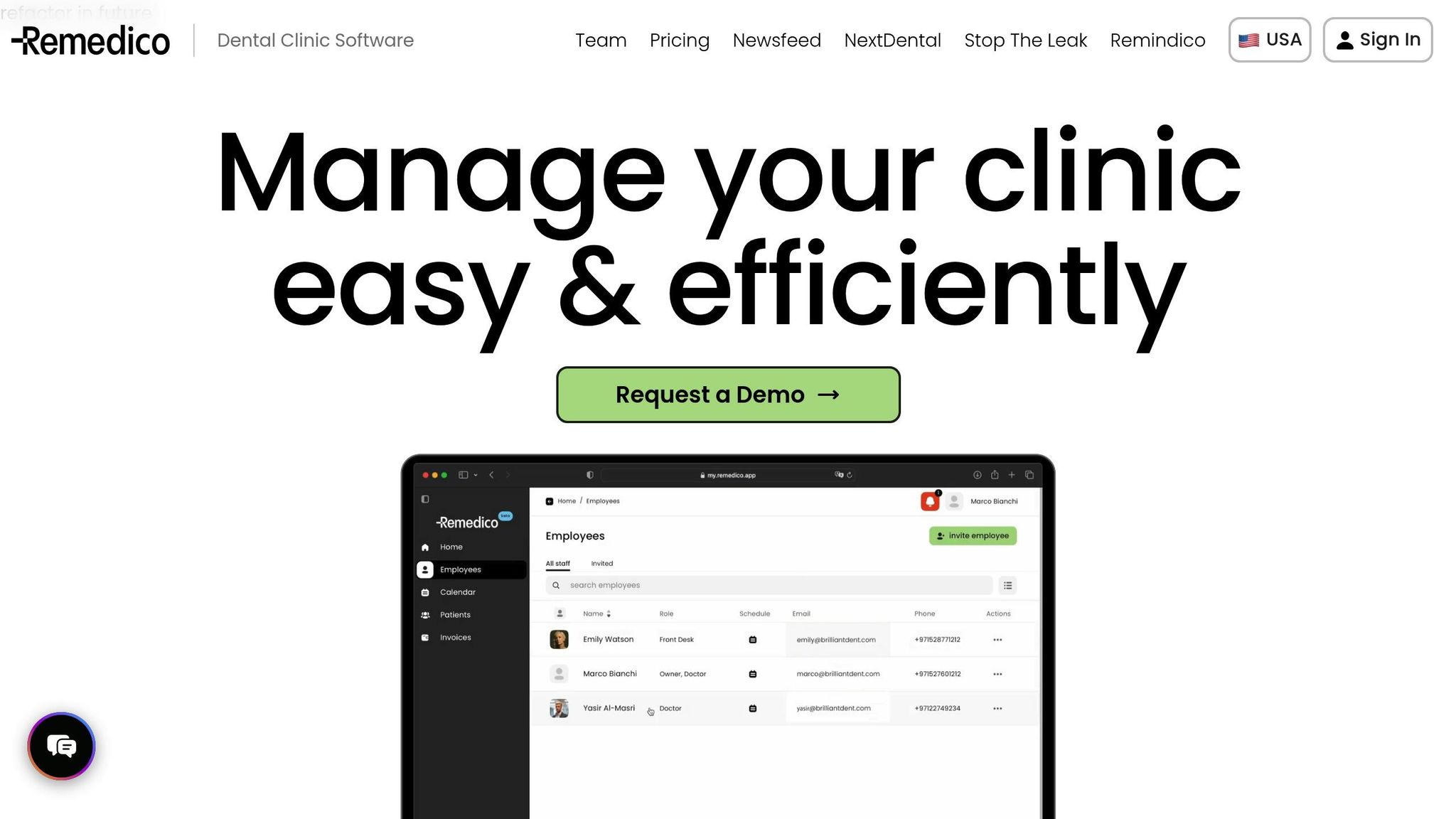
Remedico is designed to address the unique challenges faced by clinics in the UAE, MENA, and EU regions. It offers localised compliance tools, such as NABIDH integration for Dubai-based practices, and includes features like Patient Flow™ for smooth appointment management, Smart Calendar for efficient scheduling, and Dentaverse® for secure data handling.
“My daily workflow has become a breeze! As a tech-savvy dentist that loves his Apple products and the incredible interface, I always struggled with the dental software available on the market. Finding Remedico was truly life-changing. It’s just a departure from everything else I’ve used. Definitely highly recommended!” - Dr. Ahmad Khuzae, Dubai, UAE[1]
Remedico’s all-in-one platform eliminates the need for multiple vendors, reducing integration headaches, saving costs, and simplifying staff training[3]. At AED 360 per doctor each month, it offers predictable pricing along with advanced tools like RemedicoGPT™ for automated paperwork and Retention AI™ for patient follow-ups.
For clinics looking to expand, Remedico is particularly appealing. Its multi-location support allows seamless scaling from single-site practices to large multi-branch enterprises, complete with centralised dashboards and customisable features tailored to different business needs[1].
Traditional systems simply can’t compete with the comprehensive management capabilities of modern software. Clinics that delay adopting digital solutions risk falling behind as patients increasingly expect digital convenience.
The advantages of digital tools make upgrading an absolute must for clinics aiming to stay ahead in today’s healthcare landscape.
FAQs
How can I switch from a traditional dental management system to dental office software?
Transitioning from a paper-based system to dental office software doesn’t have to be overwhelming if you take it step by step. Begin by assessing your clinic’s specific needs - whether it’s managing patient records, streamlining appointment scheduling, or meeting compliance standards. This will help you pinpoint the features that matter most.
Once you’ve identified your requirements, select a dependable dental office software that aligns with your clinic’s goals. For instance, tools like Remedico come equipped with features such as Patient Flow™ for managing patient visits and a Smart Calendar to keep your scheduling organised and efficient. After choosing the right software, focus on planning the migration process. This includes transferring patient data, training your staff, and running tests to ensure the system functions as expected.
To make the transition smoother, consider rolling out the software in stages. Start with the basic features and gradually introduce more advanced tools. This phased approach reduces disruptions and gives your team time to adapt at a comfortable pace. :::
How can dental office software improve patient communication and retention compared to traditional methods?
Dental office software makes patient communication more efficient by automating important tasks such as appointment reminders, follow-ups, and updates on treatment plans. This not only cuts down on missed appointments but also ensures patients stay connected with your clinic.
Features like patient portals and messaging systems add another layer of convenience and clarity, making interactions more straightforward. These tools help establish trust and foster stronger relationships with patients. Over time, this translates into improved retention and a smoother overall experience - areas where older systems often fall short. :::
What challenges do dental clinics in the UAE face when adopting dental office software?
Dental clinics in the UAE may face a few hurdles when implementing dental office software, but these challenges can be managed with the right strategies:
- Regulatory compliance: It’s crucial that the software aligns with local health regulations like those set by the DHA or MOHAP. Additionally, it should support NABIDH integration to facilitate smooth sharing of patient records.
- Language and localisation: Considering the UAE’s multicultural environment, the software should provide multilingual options, such as Arabic and English, and include features that are relevant to the local context.
- Cost considerations: Clinics, particularly smaller ones, need to assess whether the software provides good value for money. This includes factoring in potential long-term benefits like improved efficiency and better patient retention.
Opting for a solution like Remedico can help address these issues. It offers a platform designed specifically for UAE clinics, ensuring compliance, ease of use, and cost-effectiveness. :::

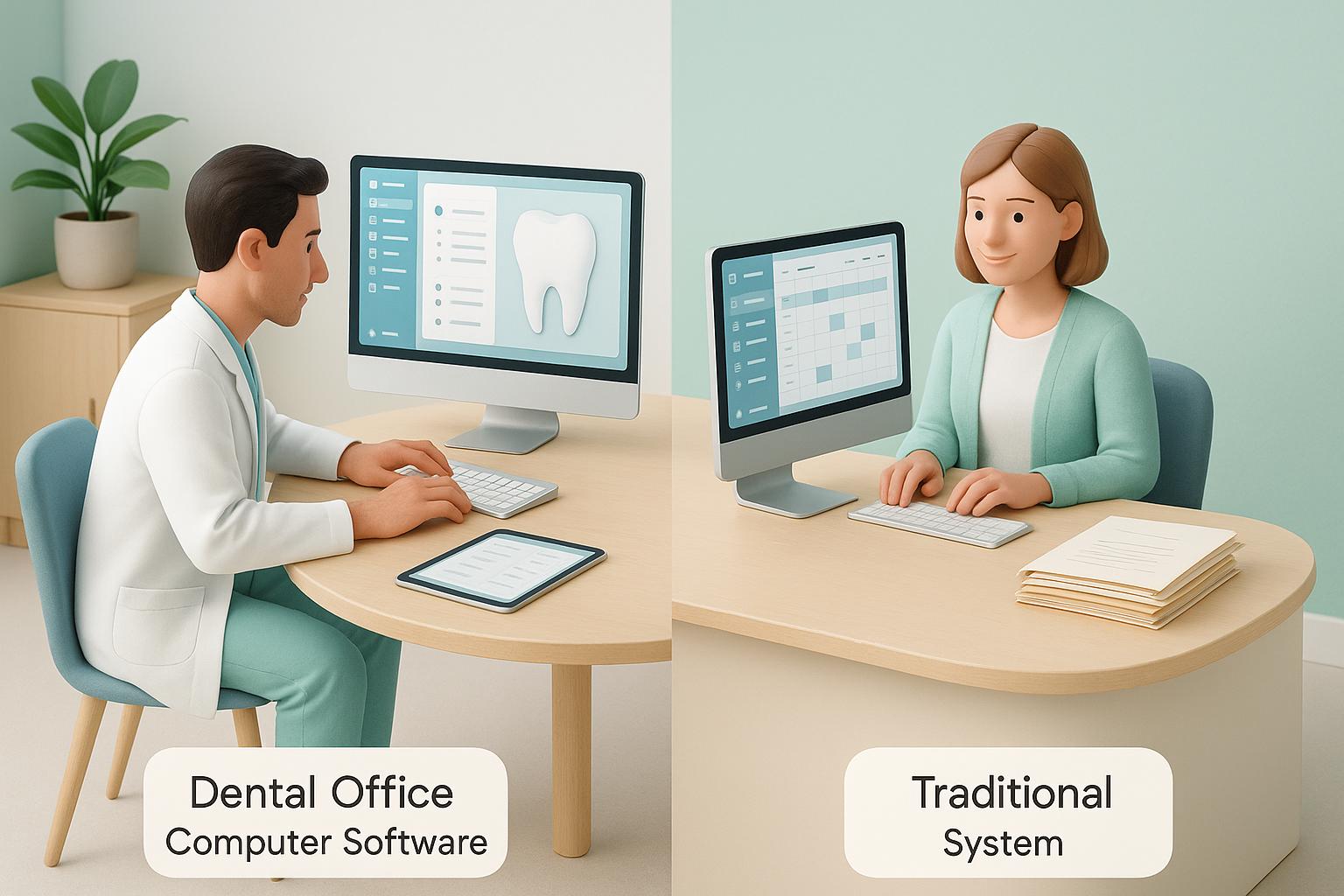
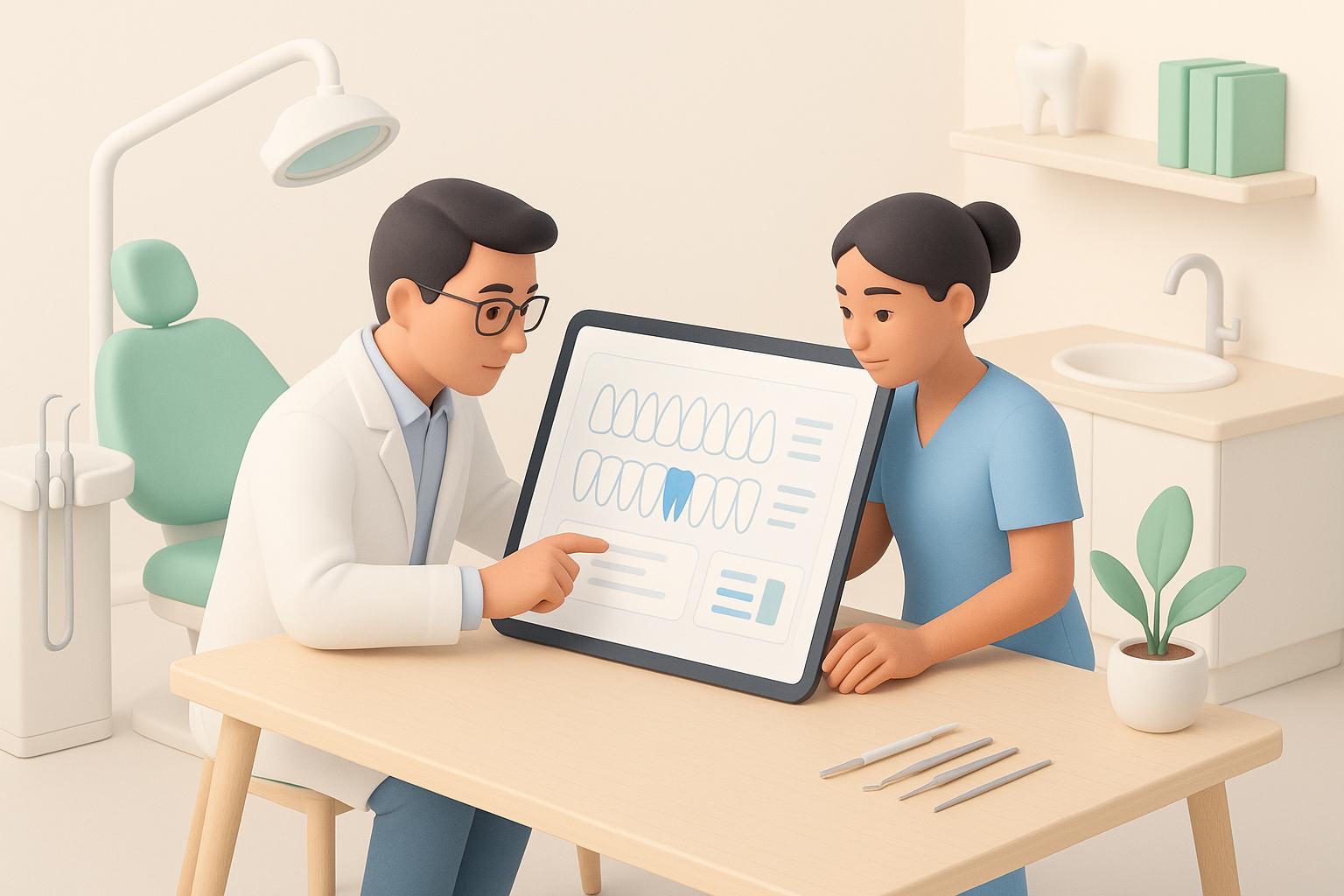
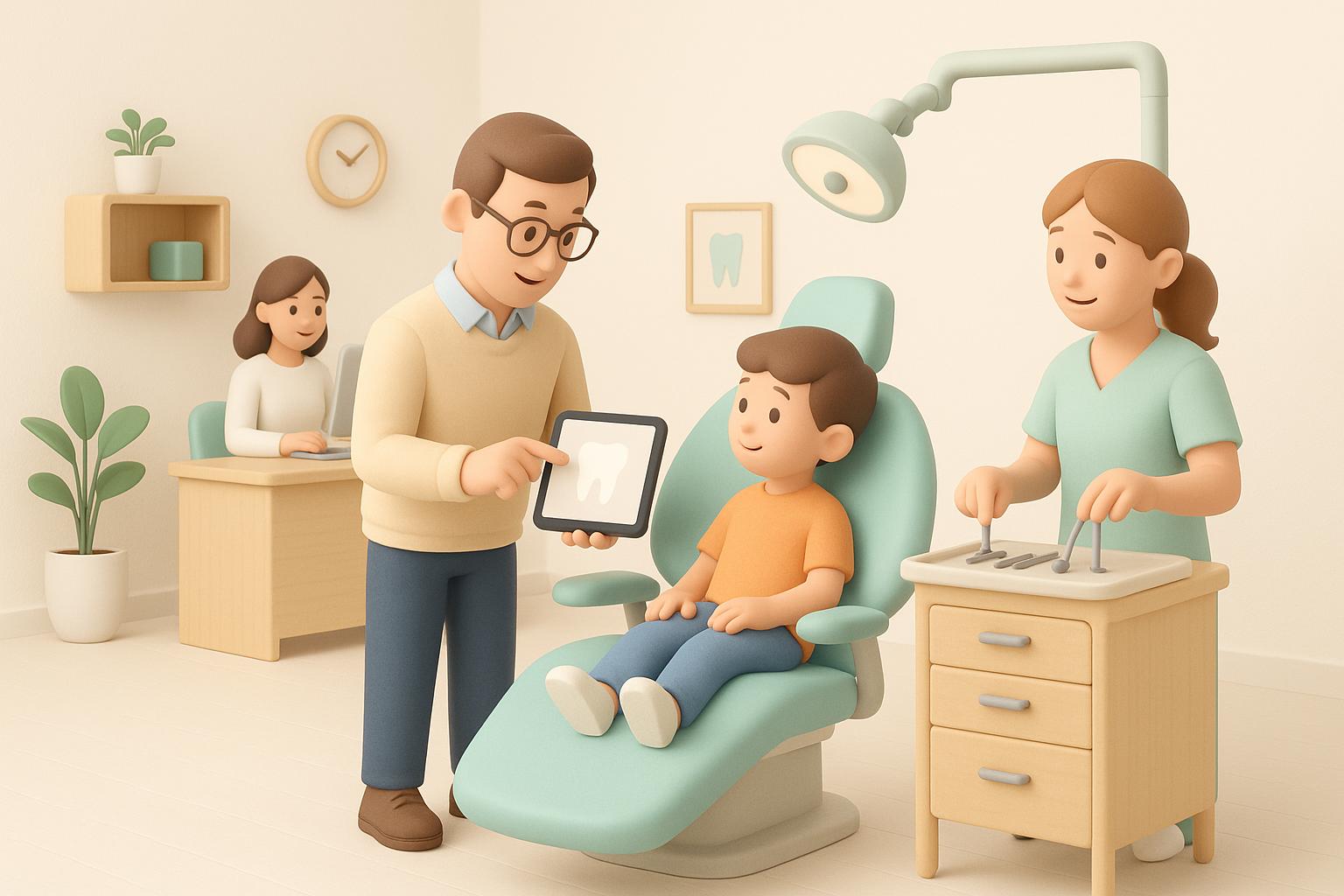
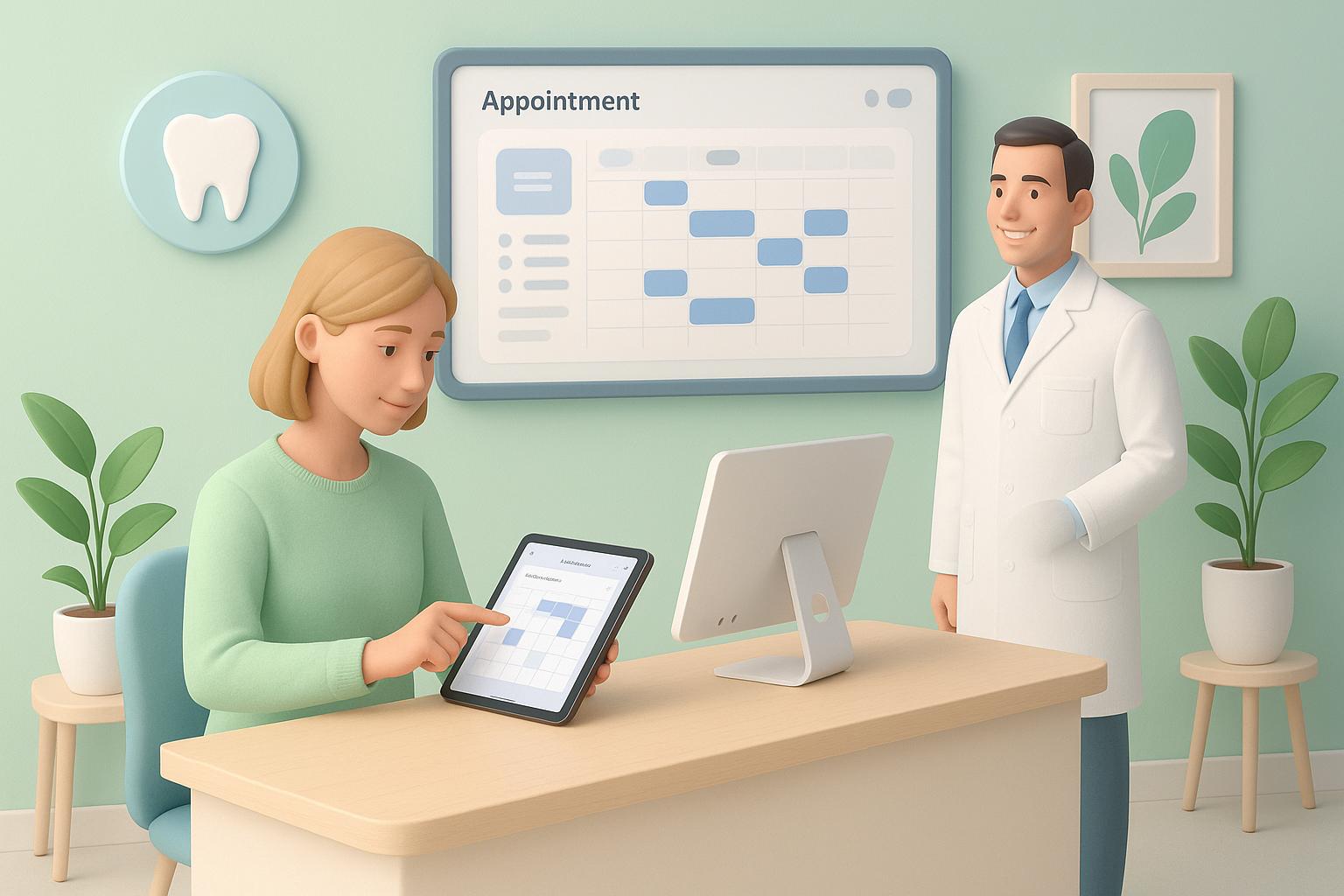


 International
International  UK
UK  Kuwait
Kuwait  Nigeria
Nigeria  Kenya
Kenya  Japan
Japan  USA
USA  France
France  UAE
UAE  South Africa
South Africa  Ethiopia
Ethiopia  Australia
Australia  Canada
Canada  Germany
Germany  Bahrain
Bahrain  Egypt
Egypt  India
India  Pakistan
Pakistan  Mexico
Mexico  Switzerland
Switzerland  Qatar
Qatar  Algeria
Algeria  Angola
Angola  Malaysia
Malaysia  Argentina
Argentina  Italy
Italy  KSA
KSA  Morocco
Morocco  Ghana
Ghana  Indonesia
Indonesia  Brazil
Brazil  Austria
Austria  Turkey
Turkey  Côte d’Ivoire
Côte d’Ivoire  South Korea
South Korea  Colombia
Colombia 

































